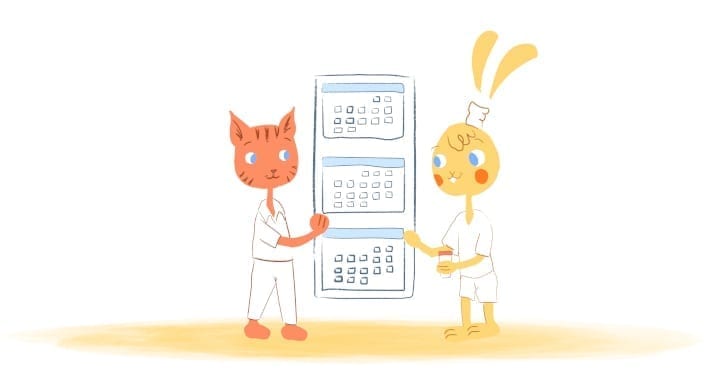

Business decision makers sometimes face adversarial priorities when it comes to decision making. In the interest of furthering the business, good decisions must be grounded in research, forethought, and collaborative brainstorming. In the interest of optimizing for productivity and responding to developing crises, decisions must be made quickly.
Is it possible to make decisions that are both good and made quickly? And if so, how do you do it?
The Push and Pull of Speed in Decision Making
There is a push and pull here that needs to be addressed. While not always the case, spending more time on a decision, assuming you spend that time productively, generally leads to a better decision and a better outcome. This gives you more time to explore the pros and cons, do research, and thoroughly consider alternative options. Because of this, optimizing for speed alone isn’t a good idea. It means you’ll sacrifice research and consideration for the sake of churning out a decision faster.
At the same time, there are situations where thorough research and slow decision making are critically disadvantageous. As a simple example, if your warehouse is on fire, you’ll lose inventory every minute that you don’t respond. Spending the extra time to explore alternative options for extinguishing it is going to cost you dearly. This is still the case even if you eventually find the most optimal approach.
Every business, every decision maker, and every situation is unique. Accordingly, you’ll need to find your own balance between fast and slow decisions.
Identify the Root Causes of Slow Decisions
One of the first things you should do is attempt to identify the root causes of your slow decisions. When do you typically take too much time to make a decision? And what happens to motivate your slow decision making?
For most business leaders, slow decisions can be attributed to one or more of the following:
Indecisiveness
Sometimes, this is merely a byproduct of indecisiveness. We all experience indecisiveness in different circumstances, sometimes in even the simplest settings, such as deciding what to order off a restaurant menu. Unfortunately, in business settings, many leaders simply postpone decisions that are ambiguous, unclear, or difficult.
Missing Data
A more excusable reason to delay a decision is because of missing or incomplete data. In many cases, it makes sense to postpone a decision if you know you’ll be getting more information soon. However, postponing a decision indefinitely because of some information that might magically appear is a bad idea.
Bureaucracy and Decision by Committee
Larger organizations are often crippled by bureaucracy and “decision by committee.” A single person making a decision will always be faster than a group of people making a decision. If a decision must be reviewed, discussed, and approved by a large team, it’s not going to be made quickly, regardless of the circumstances.
Incorporate Better Tools
Once you’ve come to better understand the root causes of your slow decisions, you can start working on incorporating better tools. Better tools in your organization will allow you to improve the organization and presentation of your data. This way, you can use that data to gain insights more quickly and make decisions faster.
For example, with a superior competitor analysis tool, you’ll be able to quickly and easily determine where your competitors stand in a variety of different categories. If you’re deciding on a topic like when to launch your new product or how to frame your new marketing campaign, this is indispensable. Instead of manually digging into the details of each of your competitors in isolation, you can quickly review data points in digestible, intuitive data visuals.
If you have better tools throughout your organization, you’ll have a much easier time getting the information necessary to make good decisions.
Define Research Prerequisites
In many cases, decision makers get lost in the weeds of research. For sufficiently complex topics, there’s literally unlimited information available. You could spend years researching the topic.
Accordingly, it pays to set some limits on what you’re going to research and explore for a given decision.
That could mean:
Parameters: It may make sense to set predefined parameters. For example, you may commit to making a decision once you learn a specific metric, like the number of users for a given tool.
Hours spent: It may also make sense to set limits on the number of hours you spend researching the decision. For example, you may commit to making a decision after spending one full hour looking into it.
A deadline: Another option is to set a deadline for yourself. For example, you may commit to making a decision on Friday, no matter what. This is arguably the weakest option, as it may preclude you from doing actual work on the decision.
Develop Frameworks for “Slow” and “Fast” Decisions
Try to develop frameworks for making decisions within your organization. A framework is a consistent system you’ll follow whenever you need to make an important decision.
For example, Gokul Rajaram and Jeff Kolovson of Square developed a framework known as SPADE, which is still in frequent use across many different businesses. SPADE stands for:
Setting: First, explore what decision needs to be made, why the decision matters, and any limitations on when the decision can be made.
People: Second, identify the people responsible for the decision, an approver to veto the decision if necessary, and consultants to help make the decision.
Alternatives: Third, as a group, brainstorm a variety of alternative decisions that can be made. These should all be feasible, different, and comprehensive.
Decide: Fourth, each individual will vote in private on the decision. The decision maker will review these votes and any available information to finalize a choice.
Explain: Finally, the decision maker will explain their rationale.
Consider developing frameworks for both slow and fast decisions. With slow decisions, you’ll have many days, or even weeks, to review all the available information and come to a choice. With fast decisions, you’ll likely have a day, a few hours, or even minutes to decide. You can’t apply the SPADE framework to a lightning-fast decision, but you can come up with a new one that’s consistently feasible, given your workplace environment.
Break Big Decisions Into Smaller Ones
Another common strategy is to take big decisions and break them into smaller ones. This can aid with indecisiveness, provide better direction on brainstorming and research, and help you execute initial decisions much faster.
For example, let’s say you’re organizing a new marketing campaign that is going to unfold across several channels and mediums. There are many individual components to decide on, and they all relate to each other. You can start by deciding on the main theme or main idea behind the campaign. Then, you can make decisions for each individual channel or piece of marketing collateral.
In line with this, if you can’t make the decision itself, you can at least make a decision for how you want to approach the decision. For example, you might decide when and how you want to approach researching the decision. It’s not much, but it’s forward progress.
Delegate and Trust
Good business decision makers don’t make decisions entirely in isolation. Instead, they surround themselves with experts and trust their advice. If you have a team of competent, trustworthy people constantly doing research and considering matters related to their own domains, you’ll have a network of people who can, at a moment’s notice, make any decision easier for you.
This requires you to build a team of experts and delegate authority and research responsibilities. It also requires you to be able to hear expert insights with thoughtful consideration. But if you can do it effectively, it can greatly accelerate decision making within your organization.
Know When to Break Indecisiveness
We’ve all experienced the paralyzing feeling of indecisiveness. This is totally understandable in some circumstances, but at a certain point, you need to find a way to break through that indecisiveness. If you’re stuck on a decision, at a certain point, you should recognize that you’re no longer making forward progress. At that point, you’ll need to come up with an alternative strategy to break the tie, such as flipping a coin.
Decentralize Your Decision Making
Decentralizing decision making isn’t always the right move, but it can be a powerful one for facilitating a faster, more capable organization. In many cases, organizations become sluggish and inelegant in their processes because they rely on complex, interwoven bureaucracies to advance every little decision. You can make your organization much more agile, and take some decisions off your own plate, if you allow your lower-level leaders to make decisions as they see fit.
Hire Fast Decision Makers
As an extension to this, you should prioritize hiring faster decision makers within your organization. You can easily screen for this during your job interviews. All you have to do is present candidates with a sufficiently complex problem to solve or a complex dilemma that requires a solution. Pay close attention to how the candidate thinks under pressure, and consider timing them to see how quickly they come up with a response. Knee-jerk reaction decisions aren’t good, but you also don’t want candidates who take 10 minutes to consider everything and still arrive at indecisiveness at the end.
Every business needs to make good decisions. Ideally, your business will be able to make good decisions much faster after employing these strategies. This is a long and somewhat challenging process, so consider integrating new tools, techniques, and tactics one at a time until you gradually optimize your decision-making structures to perfection.
Featured Image Credit: Photo by Fox; Pexels; Thank you.











Deanna Ritchie
Editor-in-Chief at Calendar. Former Editor-in-Chief, ReadWrite, Editor-in-Chief and writer at Startup Grind. Freelance editor at Entrepreneur.com. Deanna loves to help build startups, and guide them to discover the business value of their online content and social media marketing.